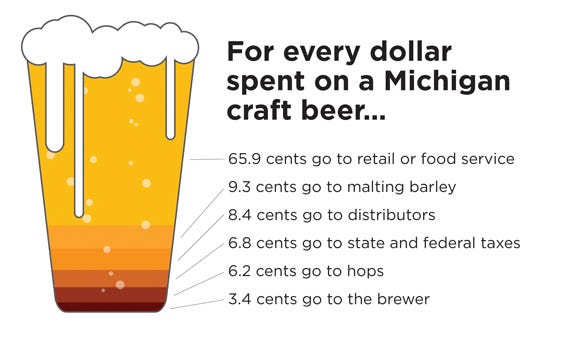May 17, 2019

By Layne Cameron
Michigan’s craft beer industry is a substantial income generator for the state.
Michigan State University has published a first-of-its-kind study in the journal Beverages that shows the economic impact of beer and craft beers’ value chain on the state of Michigan.
Not only does the study accurately quantify Michigan’s industry, but it also provides a model for all states to precisely measure their own craft beer industry.
The industry is a substantial driver in Michigan, generating nearly $500 million in gross state product in 2016, contributing nearly $1 billion and 9,738 jobs in total aggregate economic contributions. The impact could change the lens in which craft beer is viewed, says Trey Malone, MSU agricultural economist and the study’s lead author.

ECONOMIC BOOST: MSU has published a first-of-its-kind study, published in the journal Beverages, that shows the economic impact of beer and craft beers’ value chain on the state of Michigan. (Graphic by Lauren Ann Davies)

“Our results show that state governments might generate economic growth by creating a business climate that’s conducive to the growth of the craft beer value chain,” he says. “It’s definitely an industry worth fostering.”
The value chain, which the researchers describe in detail, goes beyond the brewery from which the pint was purchased.
Michigan had three microbreweries in 1993. Today, there are more than 330 — and that number is growing. In comparison, Michigan has more than twice as many breweries than the entire U.S. had in 1978.
Michigan ranks fourth in the number of breweries — first, east of the Mississippi River — and 11th overall in craft beer production. To feed this growth, hop and barley production have grown exponentially in quantity and quality.
“Specifically, hops grown in Michigan have clear attributes that differentiate varieties from those grown in Washington, Idaho and Oregon — large, hop-producing states,” says Steven Miller, study co-author and director of the Center for Economic Analysis and assistant professor of agriculture, food and resource economics. “In fact, there’s untapped potential for local hops and barley. The economic impact would be greater if consumers demand local ingredients in Michigan’s craft beers.”
Hop and barley farmers would appreciate that as well. Each pint that’s pulled, every can cracked open, trickles down to them.
“Every dollar they make comes from someone buying a Michigan beer,” says Phil Howard, study co-author and MSU associate professor of community sustainability. “And that’s not the case with Budweiser or Coors Light.”
As the industry grows, so does the variety of value-chain contributors. The number of maltsters and specialty malt producers has grown to help meet demand. Wheat and rye also are grown in Michigan, providing a nearly complete local agricultural value chain for craft beer production — one of only six states that could achieve this status.
Along with brewers, maltsters and farmers, legislators also play a critical role in industry development. States can impede or support the development of local and regional breweries and restrict the entrepreneurial activity at all levels of the value chain.
“State laws regulate every step of the value chain, and it’s formidable,” Malone says. “In Michigan, the legislative approach can be summed up as cautious but progressive.”
In comparison, states such as Mississippi and Alabama only recently made it legal to brew beer at home. Even Michigan’s southern neighbor, Indiana, permitted Sunday beer sales just last year.
“Some states focus on attracting new industries to create new jobs, but economists now recognize the value of import substitution as a way to boost regional economies; the ‘buy-local’ movement, increasing purchases within one’s own region, is a key embodiment of this concept,” Malone says. “So, regulation without a full understanding of the economic contributions can result in money and opportunities left on the table.”
Robert Sirrine, MSU Extension, and Ashley McFarland, University of Minnesota, also contributed to this research. To read the full report, visit mdpi.com.
Cameron is a Michigan State University public relations manager.
You May Also Like




